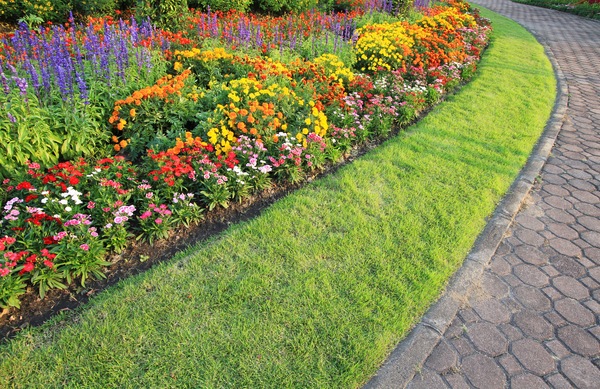When it comes to landscape design, there are many things you should know before your next DIY adventure – and Lindley's is here to help! In this blog, we cover the design building blocks, design and arrangement of plant material principles, site conditions, and formulating and executing a landscape plan. Check out these basics you need to know before tackling your next landscape design project.
Design Building Blocks
Line
- Line is a design tool well suited to directing the eye (visual) and movement (physical).
- Straight lines suggest directness, efficiency, and speed
- Curved lines, by contrast, imply a slow, restful, meandering movement.
- Lines in the landscape: edges, borders, rows of plants, or a combination of these.
Form
- Form is the mass or shape occupied by an object or group of objects.
- Example of forms, columnar, oval, vase, weeping, pyramidal, & round
Texture
- Texture is what gives an object or surface its tactile quality, from coarse to smooth.
- Use texture to change the perceived size of a space.
- Color can affect the perception of texture.
- Use one texture throughout the layers to achieve unity
Color
- Color attracts the eye and draws the attention of the viewer.
- Warm colors = Red, yellow, orange tend to advance toward the viewer.
- Cool colors = greens, violets, and blues tend to recede.
- Color can be the most temporary characteristic of plant material, yet it is the one that carries the most visual weight.
Design and Arrangement of Plant Material Principles
Proportion
- Describes the relative shape of a space.
- Plant material, garden structures, and ornaments should be considered relative to human scale.
- Other important scales include the size of house, yard, and the area to be planted.
Scale
- Scale determines how one perceives an object or a space
- Selecting plants based on mature size to fit the space
- Hardscape also give scale to a garden
Balance
- Visual weight, quantity, masses, and color are distributed relatively equally on both sides of the view axis, a composition is considered balanced.
- Formal balance repeats the same left and right, giving stability, stateliness, and dignity.
- Informal balance differs from left to right giving curiosity, movement, and feels alive. The total mass of plants needs to balance left and right.
Rhythm
- Repetition is the rhythm in landscape composition.
- Repeating line, form, color, and texture creates rhythm in the landscape.
- Too much can be monotones and too little can cause confusion.
Contrast
- Expresses differences in visual or spatial experience. Dark versus light, confined versus spacious, rugged versus manicured.
- Contrast within a plant massing is used to highlight individual plants.
Dominance
- An element that has authority in the design scheme.
- Dominance can be a focal point or a strong place of interest like a viewpoint or a place that has a special feeling.
Site Conditions
Climate
- Plants simultaneously create and respond to climate conditions.
- Vegetation contributes to the balance of soil moisture, atmospheric humidity, and soil fertility and texture, and pH.
- Beware of microclimates
Sound Attenuation
- Plants, especially dense evergreen masses, are somewhat effective in the masking of undesirable noise, especially in the high frequencies.
- Minimum of 25 feet which should include dense foliage for a buffer.
Erosion Control
- Plant roots are probably the best solution to erosion control since they have a binding effect on soil.
- A lawn is good as long as it is not too steep.
- Terrace
Formulating and Executing a Landscape Plan
- Base mapping, preliminary and intermediate design concepts, and review and revision for the preparation of final plans.
- Work with layers of plants like tree canopy, shrubs, sub-shrubs, and groundcovers.
- Designers attempt to emulate nature.
"If you think good design is expensive, look at the cost of bad design."
– Dr. Ralf Speth, CEO Jagaur
References:
-
Landscape Design: Arranging plants in the landscape by
Gail Hansen. UF Publication #ENH1188
-
Basic Principles of Landscape Design by Gail Hansen. UF
Publication #CIR536
-
Water Wise Landscaping: Principles of Landscape Design,
Colorado Master Garden Program - CMG GardenNotes
#413
